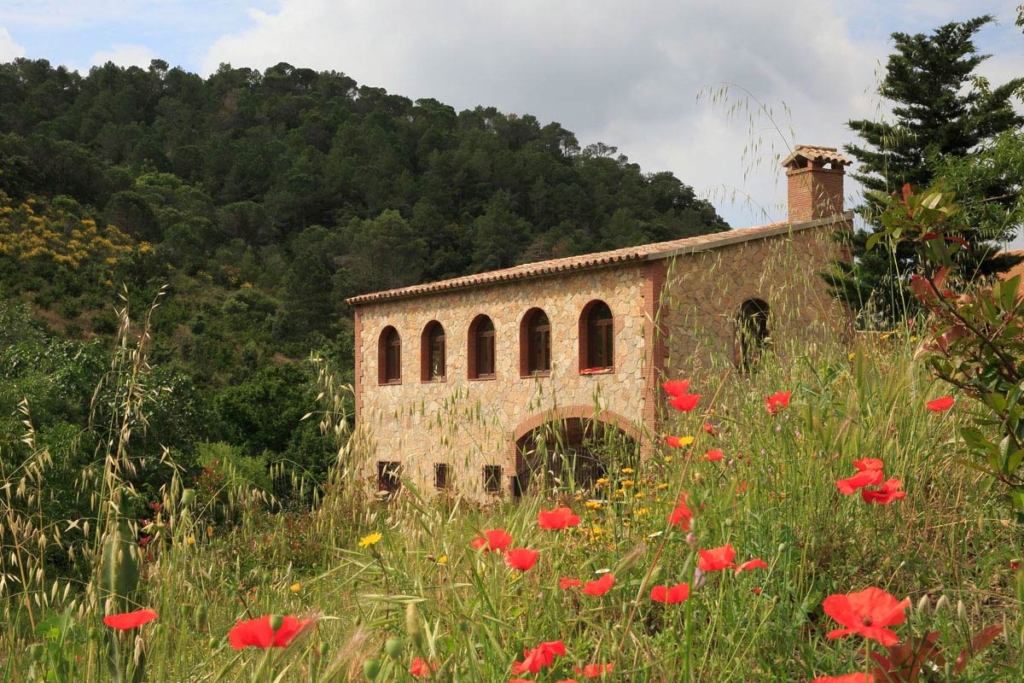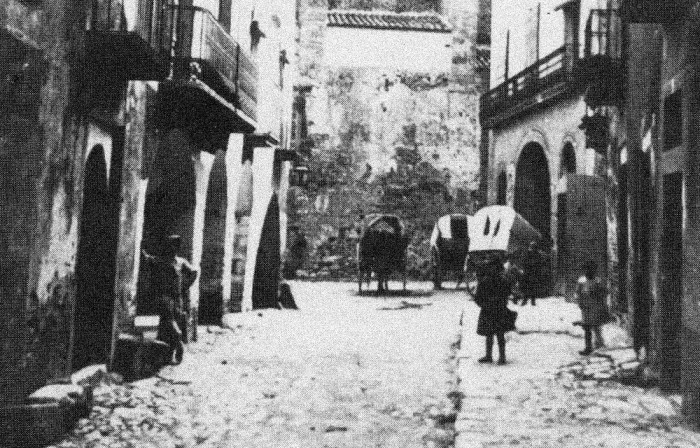THE CELLAR.
Mas del Botó is a winery located high in the Cortiella Valley, past the village of Alforja in the Baix Camp county. The source of the Cortiella river is here, giving its name to the valley. In this isolated and pristine area are vestiges of the farmhouses and of the parish of Santa María del Cortiella from bygone eras.
The agricultural exploitation consists of more than 40 hectares where 5 hectares are cultivated with vines. The Llauradó brothers come from a long winemaking tradition, and recovered their ancestral lands 30 years ago. The landscape of the Cortiella is impressive, but so is it’s history.
The valley leads into the village of Porrera (Priorat), where written records exist from the 12th century of these lands. The region of Alforja was given by the Count of Barcelona, Ramon Berenguer IV, to Ramon de Ganagot in gratitude for his military valor in the conquest of Siurana – the final Moorish stronghold in the region during the Reconquista.
That’s why our Premium wine at Mas del Botó is called Ganagot. History also extends underground in this valley, where we find remains of mining activity. Silver was mined during the time of the Romans and Arabs, and lead and iron were exploited until the end of the 1960s. Close to the Mas del Botó is Mas de Mestre, headquarters of Camp de Tarragona in the last Carlist war.
THE CELLAR.
Mas del Botó is a winery located high in the Cortiella Valley, past the village of Alforja in the Baix Camp county. The source of the Cortiella river is here, giving its name to the valley. In this isolated and pristine area are vestiges of the farmhouses and of the parish of Santa María del Cortiella from bygone eras.
The agricultural exploitation consists of more than 40 hectares where 5 hectares are cultivated with vines. The Llauradó brothers come from a long winemaking tradition, and recovered their ancestral lands 30 years ago. The landscape of the Cortiella is impressive, but so is it’s history.
The valley leads into the village of Porrera (Priorat), where written records exist from the 12th century of these lands. The region of Alforja was given by the Count of Barcelona, Ramon Berenguer IV, to Ramon de Ganagot in gratitude for his military valor in the conquest of Siurana – the final Moorish stronghold in the region during the Reconquista.
That’s why our Premium wine at Mas del Botó is called Ganagot. History also extends underground in this valley, where we find remains of mining activity. Silver was mined during the time of the Romans and Arabs, and lead and iron were exploited until the end of the 1960s. Close to the Mas del Botó is Mas de Mestre, headquarters of Camp de Tarragona in the last Carlist war.
THE CELLAR.
Mas del Botó is a winery located high in the Cortiella Valley, past the village of Alforja in the Baix Camp county. The source of the Cortiella river is here, giving its name to the valley. In this isolated and pristine area are vestiges of the farmhouses and of the parish of Santa María del Cortiella from bygone eras.
The agricultural exploitation consists of more than 40 hectares where 5 hectares are cultivated with vines. The Llauradó brothers come from a long winemaking tradition, and recovered their ancestral lands 30 years ago. The landscape of the Cortiella is impressive, but so is it’s history.
The valley leads into the village of Porrera (Priorat), where written records exist from the 12th century of these lands. The region of Alforja was given by the Count of Barcelona, Ramon Berenguer IV, to Ramon de Ganagot in gratitude for his military valor in the conquest of Siurana – the final Moorish stronghold in the region during the Reconquista.
That’s why our Premium wine at Mas del Botó is called Ganagot. History also extends underground in this valley, where we find remains of mining activity. Silver was mined during the time of the Romans and Arabs, and lead and iron were exploited until the end of the 1960s. Close to the Mas del Botó is Mas de Mestre, headquarters of Camp de Tarragona in the last Carlist war.

THE NEW FACILITIES.
The new facilities were completed in 2007, and integrate the old Mas (manor house), forming a bulwark. The original Mas preserves the brick cups, or stone basins, where the foot-trodden grapes released their juice and fermented. The building is set into the steep hillside, thereby enabling many of the processes to work by gravity.

THE NEW FACILITIES.
The new facilities were completed in 2007, and integrate the old Mas (manor house), forming a bulwark. The original Mas preserves the brick cups, or stone basins, where the foot-trodden grapes released their juice and fermented. The building is set into the steep hillside, thereby enabling many of the processes to work by gravity.
THE NEW FACILITIES.
The new facilities were completed in 2007, and integrate the old Mas (manor house), forming a bulwark. The original Mas preserves the brick cups, or stone basins, where the foot-trodden grapes released their juice and fermented. The building is set into the steep hillside, thereby enabling many of the processes to work by gravity.
THE NAME CAL BOTÓ
The name, or rather nickname, Cal Botó refers to several farms and the manor house in the region of Alforja. The name harkens back to an ancestor who, as Justice of the Peace, adjudicated a dispute between two neighbours. Deciding in favour of one neighbour, this angered the other, who in the night tried to stab the Justice. He was saved by the large medallion that he wore around his neck as a marker of his position. The knife didn’t go through the medallion (nicknamed a button, or botó). From then on, everyone referred to the Justice as Botó, and the name has remained with the estate ever since.

THE NAME CAL BOTÓ
The name, or rather nickname, Cal Botó refers to several farms and the manor house in the region of Alforja. The name harkens back to an ancestor who, as Justice of the Peace, adjudicated a dispute between two neighbours. Deciding in favour of one neighbour, this angered the other, who in the night tried to stab the Justice. He was saved by the large medallion that he wore around his neck as a marker of his position. The knife didn’t go through the medallion (nicknamed a button, or botó). From then on, everyone referred to the Justice as Botó, and the name has remained with the estate ever since.

THE NAME CAL BOTÓ
The name, or rather nickname, Cal Botó refers to several farms and the manor house in the region of Alforja. The name harkens back to an ancestor who, as Justice of the Peace, adjudicated a dispute between two neighbours. Deciding in favour of one neighbour, this angered the other, who in the night tried to stab the Justice. He was saved by the large medallion that he wore around his neck as a marker of his position. The knife didn’t go through the medallion (nicknamed a button, or botó). From then on, everyone referred to the Justice as Botó, and the name has remained with the estate ever since.
WHAT DO OUR CUSTOMER SAY.




WHAT DO OUR CUSTOMER SAY.




WHAT DO OUR CUSTOMER SAY.









